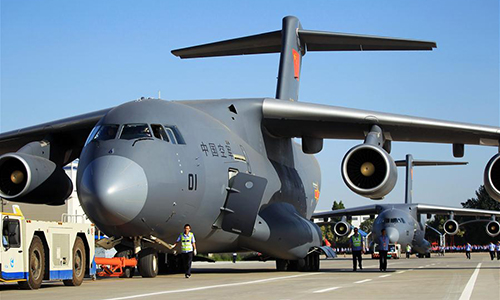China conducts first public aerial refuelling exercise between Y-20U tanker and H-6N strategic bombers

On June 23, 2025, several Chinese netizens released footage showing a simulated in-flight refuelling operation involving a Y-20U aerial tanker and two H-6N strategic bombers, bearing tail numbers 55331 and 55334. This marked the first public demonstration of a Y-20U tanker refuelling H-6N bombers and was carried out ahead of an upcoming military parade. Earlier in the month, China conducted naval exercises that included carrier strike group activities within and beyond the Second Island Chain.
Chinese analysts assess that H-6N bombers equipped for aerial refuelling are likely to conduct extended-range patrols into the western Pacific in the coming weeks. With the H-20 stealth bomber still under development, China currently relies on the H-6N and H-6K bombers, supported by the Y-20U tanker fleet. In parallel, the J-36 fighter-bomber is undergoing flight testing. The exercise and accompanying developments indicate a focus by the People’s Liberation Army (PLA) on increasing the operational range of its strategic aviation assets.
The June 23 event demonstrates the People’s Liberation Army Air Force’s (PLAAF) application of aerial refuelling in formation using probe-and-drogue systems. The Y-20U tanker refuelled two H-6N bombers simultaneously under simulated operational conditions. This configuration supports longer mission durations without requiring access to forward-deployed bases. The ability to dock multiple aircraft in-flight under formation conditions suggests advances in crew coordination, navigation procedures, and command-and-control frameworks. This capability increases the autonomy and persistence of bomber operations and enables extended patrols over maritime areas of interest. The video released by Chinese netizens also indicates an intent to communicate operational readiness to an external audience. The integration of aerial refuelling into PLAAF operational planning is now positioned as a routine capability intended to support long-distance strike missions as part of a broader air logistics system.
Strategically, this development supports China’s anti-access and area-denial (A2/AD) objectives by enhancing the range and flexibility of combined air and sea assets. By enabling H-6N bombers to reach operational distances beyond the Second Island Chain, the PLAAF now has the means to operate near or within range of U.S. and allied installations in the western Pacific, including Guam and Hawaii. The absence of a fielded H-20 bomber has resulted in the H-6N being assigned the interim role of strategic bomber, supported by aerial refuelling platforms such as the Y-20U. Analysts expect that these measures will be considered in future regional planning by the United States and allied forces. The refuelling operation also reflects a focus on validating and institutionalising China’s long-range airborne logistics and strike capability. The concurrent use of naval and air platforms suggests an increasing emphasis on joint operations over extended distances and broader maritime spaces.
The Y-20 platform was developed by Xi’an Aircraft Industrial Corporation and first flew in January 2013. It entered PLAAF service around 2016. The aerial tanker version, initially known as the Y-20U and later designated officially as the YY-20A, was first identified via satellite imagery in 2018 and reportedly completed its first flight the same year. The type entered operational service from mid-2022. As of early 2025, approximately 17 YY-20A and YY-20B aerial tankers are believed to be in service. By mid-2023, at least eight YY-20A aircraft had been confirmed operational. The YY-20 tankers are intended to replace the earlier generation H-6U refuelling aircraft. These new tankers form part of the Y-20 family and expand the aerial refuelling capacity of the PLAAF. This development contributes to China’s broader strategy to improve air mobility and extend the operational endurance of combat and support aircraft over long distances.
The YY-20A and YY-20B aerial tankers are equipped with three refuelling points, two mounted under the wings and one located on the centreline of the fuselage. This configuration enables the simultaneous refuelling of multiple aircraft. The tankers are powered by WS-20 high-bypass turbofan engines, introduced into service in late 2023. These engines increase fuel efficiency and allow for greater offload capacity. Each aircraft can carry and transfer up to 90 tonnes of fuel, which is approximately three to four times the offload capability of the older H-6U tankers. The Y-20U has conducted aerial refuelling drills with several modern PLAAF aircraft, including the J-20 stealth fighter and the J-16 multirole fighter. The platform supports operations at ranges beyond 5,000 kilometers, thereby increasing the effective radius of bomber and support aircraft. The YY-20 has become the primary aerial tanker for the PLAAF and plays a central role in enabling extended-range air operations.
The H-6 bomber family is derived from China’s licensed production of the Soviet Tu-16, which entered PLAAF service in 1969. The H-6N variant appeared in 2018 and was publicly revealed during the October 1, 2019, military parade in Beijing. This version includes a dorsal refuelling probe and a structural redesign to accommodate an external hardpoint for carrying large air-launched ballistic missiles such as the CH-AS-X-13. The H-6N also features updated avionics, including a glass cockpit, digital fire-control systems, and long-range navigation equipment. As of April 2025, approximately 120 H-6 series aircraft remain in PLAAF service, with the H-6N designated as the principal strategic bomber. The aircraft is powered by twin D-30KP-2 turbofan engines, and has a top speed of approximately Mach 0.75 and an unaided combat radius exceeding 3,500 kilometers. With in-flight refuelling, the estimated operational range reaches approximately 12,000 kilometers.
The H-6N has a payload capacity exceeding 20 tonnes and can carry a variety of long-range strike weapons. These include up to six YJ-12 supersonic anti-ship missiles, multiple land-attack cruise missiles, and the CH-AS-X-13 air-launched ballistic missile. The CH-AS-X-13 is believed to have a range of around 3,000 kilometers and may include a hypersonic glide vehicle. Analysts assess that the missile could be capable of carrying both conventional and nuclear warheads. The H-6K variant, a related development, has also been observed carrying up to four YJ-21 air-launched ballistic missiles, exceeding earlier expectations regarding payload. Combined with aerial refuelling, the H-6N platform is able to conduct strike missions targeting fixed and mobile assets across the Indo-Pacific. This capability supports China’s broader goal of establishing a long-range strike architecture, capable of integrating bomber, missile, and tanker assets into joint strategic operations. These developments provide the PLAAF with enhanced operational options in both peacetime patrols and potential conflict scenarios.





